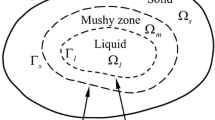Abstract
Simulation technologies are applied extensively in casting industries to understand the heat transfer and fluid transport phenomena and their relationships to the microstructure and the formation of defects. It is critical to have accurate thermo-physical properties as input for reliable simulations of the complex solidification and solid phase transformation processes. The thermo-physical properties can be calculated with the help of thermodynamic calculations of phase stability at given temperatures and compositions. A multicomponent alloy solidification model, coupled with a Gibbs free energy minimization engine and thermodynamic databases, has been developed. A back diffusion model is integrated so that the solidification conditions, such as cooling rate, can be taken into account.









Similar content being viewed by others
References
Lukas H.L.,Weiss J., Henig E.Th. (1982) Strategies for the Calculation of Phase Diagrams. CALPHAD 6(3):229-251
U.R. Kattner, The Thermodynamic Modeling of Multicomponent Phase Equilibria, JOM, 1997, 49, p 14-19
Saunders N., Miodownik A.P.(1998) CALPHAD: Calculation of Phase Diagrams A Comprehensive Guide. Elsevier Science Ltd, New York, NY, p 299–411
N. Saunders, Z. Guo, X. Li, A.P. Miodownik, and J-Ph. Schillé, Using JMatPro to Model Materials Properties and Behavior, JOM, 2003, Dec., p 65
J. Guo and M.T. Samonds, Property Prediction With Coupled Macro-Micromodeling and Computational Thermodynamics, Hwang Weng-Sing and Kaohsiung, Ed., Modeling of Casting & Solidification Processes, Taiwan, 2004, p 157-164
Brody H.D., Flemings M.C. (1966) Solute Redistribution during Dendrite Solidification. Trans. Met. Soc. AIME p 236:615
Clyne T.W., Kurz W. (1981) Solute Redistribution during Solidification with Rapid Solid State Diffusion. Metall. Trans. 12A:965
Ohnaka I. (1986) Mathematical Analysis of Solute Redistribution during Solidification with Diffusion in Solid Phase. Trans. ISIJ 26:1045
Wang C.Y., Beckermann C. (1993) Unified Solute Diffusion Model for Columnar and Equiaxed Dendritic Alloy Solidification. Mater. Sci. Eng. 171:199
Nastac L., Stefanescu D.M. (1993) An Analytical Model for Solute Redistribution during Solidification of Plannar, Columnar and Equiaxed Morphology. Metall. Trans. 24A:2107
Voller V.R., Beckermann C. (1999) A Unified Model of Microsegregation and Coarsening. Metall. Trans. 30:2183
Voller V. R. (2001) On a General Back-diffusion Parameter. J. Cryst. Growth 226:562–568
Schneider M.C., Gu J.P., Beckermann C., Boettinger W.J., Kattner U.R. (1997) Modeling of Micro- and Macrosegregation and Freckle Formation in Single-Crystal Nickel-Base Superalloy Directional Solidification. Met. Mat. Trans. A 28A:1517–1531
X. Yan, Thermodynamic and Solidification Modeling Coupled with Experimental Investigation of the Multicompoent Aluminum Alloys, Ph.D. Thesis, University of Wisconsin-Madison, Madison, WI, 2001
Wang C.Y., Beckermann C. (1993) A Multiphase Solute Diffusion Model for Dendritic Alloy Solidification. Met. Trans. A, 24A:2787–2802
Ohnaka I. (1986) Mathematical Analysis of Solute Redistribution during Solidification with Diffusion in Solid Phase. Trans. ISIJ, 26:1045–1052
X.L. Yang, P.D. Lee, R.F. Brooks, and R. Wunderlich, The Sensitivity of Investment Casting Simulations to the Accuracy of Thermophysical Property Values, TMS Ed., Superalloys, The Minerals, Metals & Materials Society, 2004
Alkan B., Karabulut R., Unal B. (2002) Electrical Resistivity of Liquid Metals and Alloys. Acta Phys. Pol. A, 102:385–400
Rossiter P.L., (1987). The Electrical Resistivity of Metals and Alloys. Cambridge University Press, New York, NY, pp. 137–272
Rudajevova A., Stanek M., Lukac P. (2003) Determination of Thermal Diffusivity and Thermal Conductivity of Mg-Al Alloys, Mat. Sci. Eng., A A341:152–157
Klemens P.G., Williams R.K. (1986) Thermal Conductivity of Metals and Alloys. Int. Mat. Rev. 31(5):197–215
Sichen D., Bygden J., Seetharaman S. (1994) A Model for Estimation of Viscosities of Complex Metallic and Ionic Melts. Met. Mat. Trans. B 25B(August):519–525
N. Saunders, X. Li, A.P. Miodownik, and J.P. Schille, Modeling of the Thermo-Physical and Physical Properties for Solidification of Al-Alloys, Light Metals, 2003, p 999–1004
Author information
Authors and Affiliations
Corresponding author
Rights and permissions
About this article
Cite this article
Guo, J., Samonds, M.T. Alloy Thermal Physical Property Prediction Coupled Computational Thermodynamics with Back Diffusion Consideration. J Phs Eqil and Diff 28, 58–63 (2007). https://doi.org/10.1007/s11669-006-9005-6
Received:
Published:
Issue Date:
DOI: https://doi.org/10.1007/s11669-006-9005-6



